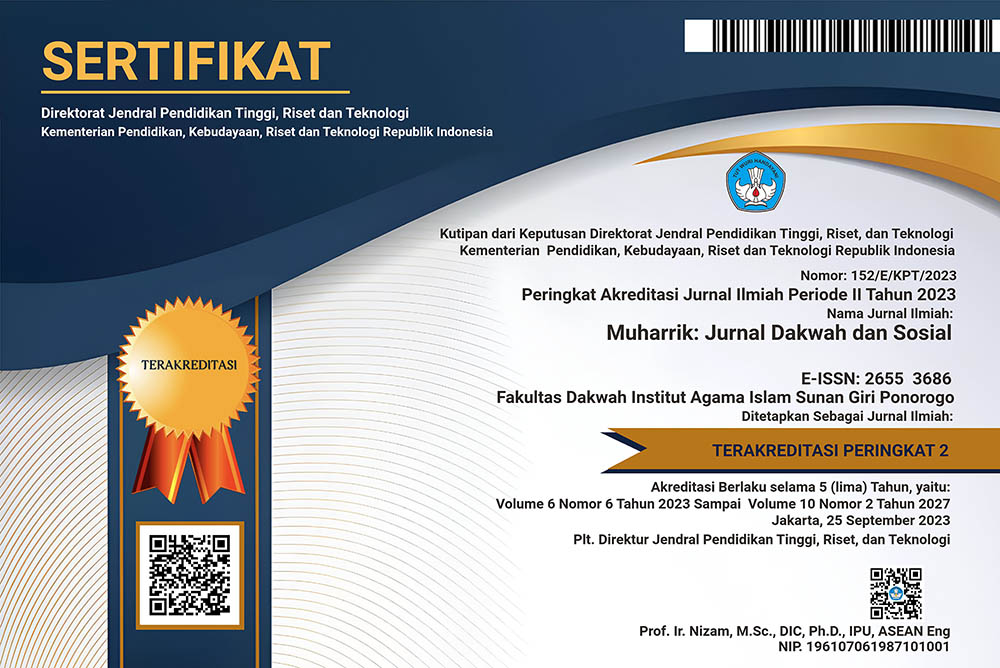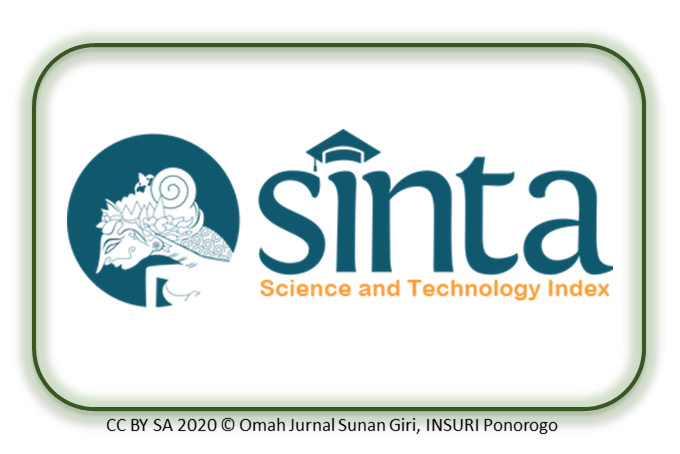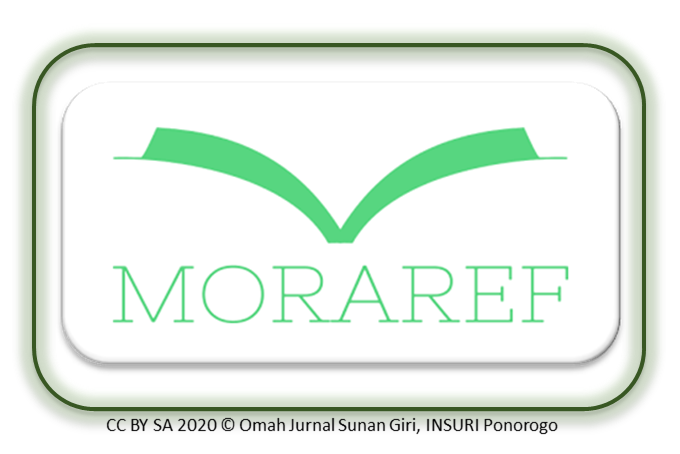Kinship and Social Integration: Ethnographic Study of Shia and Sunni Alawiyin Relations in Palembang
DOI:
https://doi.org/10.37680/muharrik.v7i1.6934Keywords:
Social Relations, Shia Alawiyin, Sunni AlawiyinAbstract
This study aims to examine in depth the dynamics of social relations between the Shia Alawiyin and Sunni Alawiyin groups in Palembang City. Despite differences in their schools of thought, these two groups are able to coexist without causing open conflict, a condition rarely studied in the literature on intra-community Muslim relations. The knowledge gap lies in the lack of understanding of how kinship ties function as a determining factor in reducing the potential for sectarian conflict. This study uses a qualitative approach with a case study design, involving 12 purposively selected participants. Data collection techniques were carried out through participant observation and in-depth interviews, then analyzed using the ethnographic framework of Spradley and McCurdy. The results show that social relations between Shia and Sunni Alawiyin form associative and dissociative patterns. The associative pattern is reflected in the form of cooperation in the fields of trade, da'wah, and involvement in socio-religious activities. The dissociative pattern is characterized by limited failure that does not develop into open conflict. The most important factor in mitigating potential conflict is the strength of kinship ties (jama'ah) among the Alawiyin. Theoretically, these findings contribute to the study of social integration in pluralistic societies, while practically, they emphasize the importance of strengthening family and cultural solidarity in maintaining social harmony.
Downloads
References
M. Terjemah Az Zahidiy (ed.)).
Alatas, I. F. (2016). The poetics of pilgrimage: assembling contemporary Indonesian pilgrimage to Ḥaḍramawt, Yemen. Comparative Studies in Society and History, 58(3), 607–635.
Aljunied, S. Z. (2013). The genealogy of the Hadhrami Arabs in Southeast Asia–the ‘Alawi family. 1–10.
Behuria, A. K. (2004). Sunni‐Shia relations in Pakistan: The widening divide. Strategic Analysis, 28(1), 157–176.
Finnbogason, D., Larsson, G., & Svensson, I. (2019). Is Shia-Sunni violence on the rise? Exploring new data on intra-Muslim organised violence 1989-2017. Civil Wars, 21(1), 25–53.
Herlina, H. (2018). Tradisi dan Warisan Intelektual Ulama Palembang abad ke-18 hingga awal abad ke-20 (Disertasi). Universitas Islam Negeri Raden Fatah Palembang.
Ilyas, Y., Sam, H. I., & Amirsyah, T. (2020). Mengenal dan mewaspadai penyimpangan Syi’ah di Indonesia. Al-Qalam.
Latief, H. (2008). The Identity of Shi ‘a Sympathizers in Contemporary Indonesia. Journal of Indonesian Islam, 2(2), 300–335.
Moore, J. (2015). The Sunni and Shia schism: Religion, Islamic politics, and why Americans need to know the differences. The Social Studies, 106(5), 226–235.
Mufidah, L. N. (2013). Konsep Pendidikan Islam Perspektif Filosof Muslim dan Praktisi Abad Modern: Muhammad Abduh dan Muhammad Iqbal. Dalam Jurnal Ilmu Tarbiyah “Tajdid, 2(2).
Muhammad, A. (2020). Konstruksi Pemikiran Syeikh Muhammad Azhari Al-Falimbani dalam Kitab ‘Athiyah Ar-Rahman tentang Sifat Wajib Nabi dan Rasul. Universitas Raden Fatah Palembang.
Rafiq, A. (2014). Sunni Deobandi-Shia Sectarian Violence in Pakistan. Middle East Institute. Rumahuru, Y. Z. (2020). Kebudayaan dan Tradisi Syiah di Maluku: Studi Kasusu Komunitas
Muslim Hatuhaha.
Seise, C. (2018). Women remembering the Prophet’s birthday: Maulid celebrations and religious emotions among the Alawiyin community in Palembang, Indonesia. ASEAS- Austrian Journal of South-East Asian Studies, 11(2), 217–230.
Sharma, K. (2016). What causes extremist attitudes among Sunni and Shia Youth? Evidence from northern India. In Evidence from Northern India (p. 5). Program on Extremism George Washington University.
Slama, M. (2014). Indonesian Hadhramis and the Hadhramaut: An old diaspora and its new connections. Antropologi Indonesia, 29(2), 107–113.
Spradley, J. P., & McCurdy, D. W. (1972). The cultural experience: Ethnography in complex society. Science Research Associates.
Sulaiman, S. (2017). Relasi Sunni-Syiah: Refleksi Kerukunan Umat Beragama di Bangsri Kabupaten Jepara. Panangkaran: Jurnal Penelitian Agama Dan Masyarakat, 1(1), 19– 36.
Taufani, T. (2020). Dinamika Internal Masyarakat Muslim Minoritas (Studi atas Relasi Sunni dan Syi’ah di Manado). Universitas Islam Negeri Alauddin Makassar.
Yatim, B. (1998). Perubahan Sosial Politik di Hijaz 1800-1925 dan Pengaruhnya Terhadap lembaga dan Kehidupan Keagamaan. In Disertasi--UIN Syarif Hidayatullah, Jakarta. UIN Syarif Hidayatullah.
Zahra, F., & Ghufron, M. (2018). Strategi Pengembangan Nilai-Nilai Toleransi dalam Relasi Sosial Sunni-Syi’ah di Perkampungan Candi Desa Banjaran–Jepara. Islamic Review: Jurnal Riset Dan Kajian Keislaman, 7(2), 158–173.
Zulkifli, Z. (2009). The Education of Indonesian Shi ‘i Leaders. Al-Jami’ah: Journal of Islamic Studies, 47(2), 231–267.
Downloads
Published
How to Cite
Issue
Section
License
Copyright (c) 2024 Muhammad Noupal, John Supriyanto

This work is licensed under a Creative Commons Attribution-NonCommercial 4.0 International License.
The author(s) retain/s the copyright and grant/s Muharrik: Jurnal Dakwah dan Sosial the first publication rights licensed under the Creative Commons Attribution-NonCommercial 4.0 International (CC BY-NC 4.0) , which allows others to access (search, read, download and quote), share (copy and redistribute the material in any media or format) and adapt (mix, modify and develop) works for legitimate non-commercial purposes, with recognition of the authorship of the work and its initial publication in this journal.












